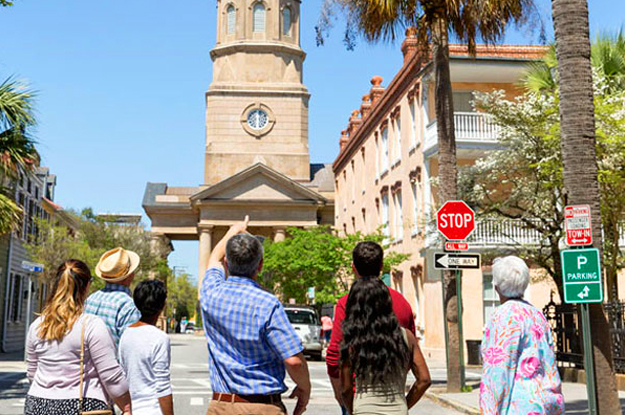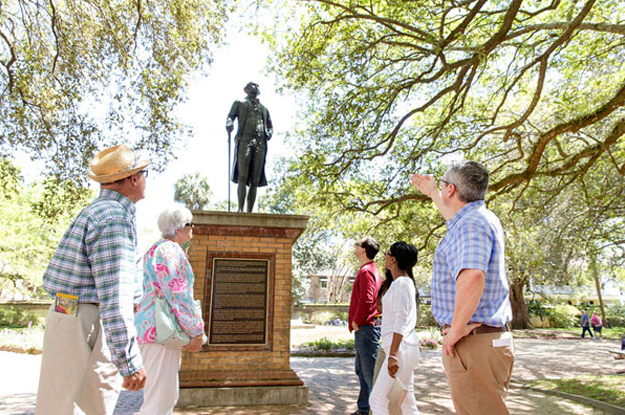
Historic Charleston is history preserved. For history buffs, it’s a treasure-trove of sites covering a long span of American history – Colonial, Antebellum and Civil War. The long list of well-preserved historic homes, churches and public buildings of this charming city are located in the Historic District of Downtown, a 4-5 square mile, the low-lying land between the Ashley and Cooper rivers.
Although The Peninsula is the location of most of the magnificent antebellum homes and churches so closely identified with Charleston, other historically significant sites are a short distance away. Civil War era Fort Sumter, visible in the harbor from the Battery, is accessible by ferry from Liberty Square Visitor Educational Center. The landing spot of the first settlers and early 18th century plantations along historic Ashley River Road are a 15 to 20-minute car ride away.
Throughout Historic Charleston, the architecture, foliage, and tropical colors reflect its early heritage which combined the elegance of Restoration England and color of the West Indies. Unlike the austere Puritan English who settled colonial Boston, the English settlers who first settled in Charleston came by way of the English colony of Barbados. They came to build an aristocratic city founded on the accumulation of wealth through agriculture, shipping and trade.
When they found the land was not suitable for growing sugar cane which had led to great wealth in Barbados, they discovered that the extreme tide variances and barely above sea level Lowcountry soil were perfect for the cultivation of rice. Residents of Charles Towne prospered through the growing and trading of “Carolina Gold.” They also traded in slavery as slave labor was used to work the rice fields. Charles Towne grew to become an important stop on the maritime trade route running from England to New England to the West Indies.
ASHLEY RIVER SITES: COLONIAL & REVOLUTIONARY WAR ERA
Charles Towne Landing Historic Site
This is a place to begin the historic Charleston experience. The marshy point on the Ashley River is where the first English settlers stepped ashore in 1670. Exhibits and an audio tour along a historic trail tell the early settlement’s story.

Magnolia Plantation & Gardens
An expansive rice plantation on Ashley River Drive was first settled by Thomas and Ann Drayton in 1676. Generations of Drayton’s took pride in their beautiful romantic style gardens where plantings work with nature to create a harmonious landscape. After the Civil War, the family focus turned to the gardens which become the first public garden in America. The house has undergone various renovations, and only its core dates to the Revolutionary War era, during which the grounds were occupied by both British and America troops. House tours are a glimpse into plantation life in the early 1800s.
Drayton Hall
The earliest and finest example of Georgian Palladian architecture in the U.S. The elegant 1738 home was the center of life on the riverfront rice plantation. Don’t expect a house filled with period furnishings and decorative objects. It is devoid of furnishings as the decision was made to preserve, not restore the architectural treasure.
Middleton Place
Another Ashley River Road rice plantation was the home of Declaration of Independence signer, Arthur Middleton. Built in 1755, it’s known for its formal, landscaped grounds, the oldest in America. The elegant house museum is beautifully appointed in furnishings of four generations of Middletons. In the Stableyards, demonstrations by costumed interpreters of skills once performed by enslaved people, give visitors a sense of life on a Lowcountry rice plantation.
THE PENINSULA
Street after street, the charming Historic District has so much to see and take in. For first time visitors, a walking or carriage tour is a must. Both are wonderful Charleston experiences to see, learn and experience by traveling along the narrow picturesque streets as trained guides lead the way, pointing out the sights. Trusted Tours & Attractions offers discount tickets for Old South Carriage Tours and Charleston Strolls History Walk. After the tour, check out these highlights:
COLONIAL & REVOLUTIONARY WAR SITES
Old Exchange Building & Provost Dungeon
One of the three most historically significant Colonial buildings in the U.S. During the 1760s and 1770s, when Charles Towne was the most prosperous port in the south, the Exchange, and Custom House was the commercial, political and social center of the community and the site of many historical gatherings leading to Independence. It housed a Revolutionary War dungeon and was the site of the ratification of the U.S. Constitution.
Heywood Washington House
A well-appointed Georgian-style double house built in 1772, and the town home of Thomas Hayward, Jr., one of the signers of the Declaration of Independence. It is richly furnished and the 1740s kitchen is the only one open to the public. George Washington used the home during his visit to Charleston in May 1791.

Slave Mart Museum
On cobblestone Chalmers St. tells the story of Charleston’s role in the inter-state slave trade after the international slave trade was banned in 1808. Until forced to move to indoor parts in 1856, slaves were sold on the north side of the Old Exchange building.
19th CENTURY ANTEBELLUM HOUSE MUSEUMS
Joseph Manigault House
Built in 1803, it reflects the in-town lifestyle of wealthy rice planters and their families. The tour also gives insight into the lives of African American slaves who lived and worked there. From the amazing free-standing spiral staircase to room filled with elegant period furniture, the house tells the story of the prosperity, wealth, and stature.
Nathaniel Russell House
One of America’s most important neoclassical homes. The 1808 home of a prosperous merchant, Nathaniel Russell, whose fortune came from trading Carolina Gold, indigo, tobacco, cotton, is restored to its grandeur.
Edmondston-Alston House
Constructed in 1825, has a wonderful view of Charleston harbor. On April 12, 1861, General P.T. Beauregard watched the bombardment of Ft. Sumter from the piazza, and in December of that year, General Robert E. Lee stayed in the home.
Aiken-Rhett House
A unique. Built by merchant John Robinson in 1830 as a double house with a central hallway and two rooms on either side, it was enlarged and renovated in 1833 into the palatial home of William Aiken, Jr. A large number of African-American slaves lived on the property to sustain the Aiken’s lifestyle. The house and property, including the original outbuildings, have been preserved, not restored.
HISTORIC CHURCHES IN THE “HOLY CITY”
Steeples of historic churches of all denominations tower over the “Holy City”, skyline. Go into anyone you pass or pick from these early churches:
St. Philip’s Episcopal Church
The oldest congregation in Charleston, dating to 1681, is the best-known. The National Historic Landmark has an ancient feel inside.
St. Michael’s Episcopal Church
This place is massive, has beautiful wooden pews, stained glass, bells that date to 1764, and an organ that has been in the church since 1767.
St. John’s Lutheran Church
Known as the house of worship of the oldest Lutheran congregation in the South, dating to 1742, has a stunning interior.
The Unitarian Church
The congregation dates to 17 and is the oldest Unitarian church in the South. The lovely Gothic church is a National Historic Landmark.
